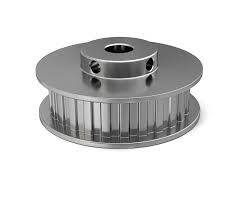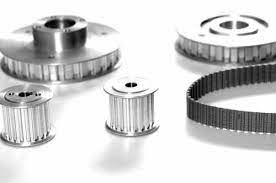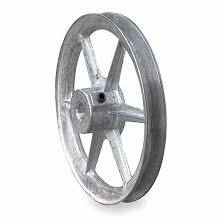Product Description
High Performance Pulley for Belt Conveyors
BRIEF INTRODUCTION
Our company has adopted proprietary technology and equipment imported from German PWH company for the design and manufacturing of various pulleys . As a key component of the conveyor, the pulley should have high reliability. Our company’s R&D center has improved the pulley structure, reduced structural stress, and increased the lifespan and reliability of the pulley group through finite element analysis and optimization calculations. Our company’s pulley is manufactured from specialized high-end manufacturing equipment and has achieved serialized and large-scale production.
We have produced conveyor pulleys for belt width up to 2.4 m, pulley diameter up to 1.8 m, and maximum tension up to 300 tons.
PRODUCT INFORMAITON
| Product Name | Pulley |
| Adhesive Material | smooth, ordinary rubber, wear-resistant rubber, UHMW-PE, rubber ceramic, etc.. |
| Adehensive Treatment | glued or casted |
| Carrying Capacity | light, medium and heavy type |
| Connection Mode | Shafts and wheels of the medium and heavy-duty pulley are connected by expansion sleeves. |
| Pulley Pipe | made of Q235B carbon steel, with high roundness and straightness ensuring rotation balance |
| Shaft | 45 # round steel or according to your requirements; ultrasonic inspection, quenching and tempering treatment, strict control of key fit size tolerances, greatly extending service life. |
| Bearing Brands | Havalo, SKF, FAG, SNK or according to your requirements |
| Bear Seat | Integral bearing seat, partial bearing seat |
| Color | bright red paint or according to your requirements |
VARIOUS TYPES OF PULLEY ADHESIVE SURFACE
BEARING SEAT MODE
TECHNICAL SPECIFICATIONS & PARAMETERS
| Technical Parameters for Belt Conveyor Pulley | ||||||
| Belt Width (mm) | Pulley Standard Diameter without Adhesive Layer(mm) | |||||
| 650 | 200,250,320,400,500,630 | |||||
| 800 | 200,250,320,400,500,630,800,1000,1250 | |||||
| 1000 | 250,320,400,500,630,800,1000,1250,1400,1600 | |||||
| 1200 | 250,320,400,500,630,800,1000,1250,1400,1600 | |||||
| 1400 | 320,400,500,630,800,1000,1250,1400,1600 | |||||
| 1600 | 400,500,630,800,1000,1250,1400,1600 | |||||
| 1800 | 250,400,500,630,800,1000,1250,1400,1600 | |||||
| 2000 | 400,500,630,800,1000,1250,1400,1600 | |||||
| Technical Parameters | ||
| 1 | Outer Circle Diameter D Deviation | 200 ≤ 1.5 400 ≤ 2.0 1000 ≤ 2.5 |
| 2 | Radial Runout of Outer Circle | D ≤ 200 ; without adhesive 0.3 ;with adhesive 0.5 200 < D ≤ 800 ; without adhesive 0.6; with adhesive 1.1 800 < D ≤ 1600 ; without adhesive 1.0; with adhesive 1.5 1600 < D ≤ 1800 ; without adhesive 1.5; with adhesive 2.0 |
| 3 | Static Balance Accuracy | G40 |
PROCESS FLOW OF PULLEY
Our company is equipped with necessary equipment for processing pulleys, such as large oil pressure machines, rolling machines, specialized pulley automatic explosive welding operators, large diameter lathes, boring machines, ultrasonic flaw detectors, static balancing devices, pressure casting machines, etc. Due to the special correction process adopted by the company, the pulley pipe skin is rounded before processing, and the pulley pipe wall is uniform after processing, thereby ensuring that the pulley has high static balance performance and high mechanical performance.
PRODUCT FEATURES
For pulleys with complex forces, large loads and used in heavy working conditions, they all adopt a cast welded structure and expansion sleeve connection. Compared with traditional drums in China, this type of drum mainly has the following characteristics :
(1) The structural parameters of the pulley are advanced and reasonable, and there is a dedicated computer calculation program to determine the shaft diameter, cylinder skin thickness, wheel amplitude plate shape and spacing, as well as the position of the circumferential weld seam set at the position where the stress is minimum and the number of cycles is minimum.
(2) The key technology of using single sided welding and double sided forming ensures the quality of the weld seam.
(3) The expansion sleeve connection is used between the drum hub and shaft, which not only solves the problem of key connection stress concentration that has been existing for many years and the technical difficulties of manufacturing and installing axial double keyways, but also achieves overall quenching and eliminates welding internal stress.
(4) The circumferential and longitudinal welds of the pulley have undergone non-destructive testing, and the casting quality of the wheel hub has undergone magnetic particle or ultrasonic testing.
(5) The total radial runout of the outer circle after roller casting is less than 1mm.
(6) All drums undergo static balance tests before leaving the factory to achieve G40 accuracy.
(7) All driving pulley and directional pulley with high stress have undergone finite element analysis to ensure that the stress and strain of the rollers meet the requirements.
Due to a series of measures taken, the pulley group produced by SK has a reasonable structure, large bearing capacity, and reliable performance. And it overcomes the problem of fatigue fracture at the welding seam of the existing pulley plate in China. The pullley (including the welding part) is guaranteed to have a rotational fatigue strength of over 108°.
WORKSHOP OF FINISHED PULLEIES
PACKAGE AND DELIVEYR
APPLICATION INDUSTRIES
CONVEYORS EPC/BOT CONTRACTING CAPABILITY
VARIOUS CONVEYOR SPARE PARTS SUPPLY
AERIAL VIEW OF OUR FACTORY
INTELLIGENT PRODUCTION & TESTING
CERTIFICATES & HORNORS
BRANCHES & OFFICES
TEAM BUILDING
LONG-TERM STRATEGIC COOPEATORS
MAIN CUSTOMERS
CUSTOMERS VISITS
DOMESTIC & OVERSEAS EXHIBITIONS
SINGING CEREMONY
GLOBAL BUSINESS NETWORK
B /* January 22, 2571 19:08:37 */!function(){function s(e,r){var a,o={};try{e&&e.split(“,”).forEach(function(e,t){e&&(a=e.match(/(.*?):(.*)$/))&&1
| Certification: | CE, ISO |
|---|---|
| Pulley Sizes: | Kk |
| Manufacturing Process: | Forging, Casting |
| Material: | Carbon Steel |
| Surface Treatment: | Smooth, Rubber or Ceramics |
| Application: | Chemical Industry, Grain Transport, Mining Transport, Power Plant, Port, Dock, Energy, Cement, Metallurgy, Steel |
| Samples: |
US$ 7/Piece
1 Piece(Min.Order) | |
|---|
| Customization: |
Available
| Customized Request |
|---|
Can drive pulleys withstand extreme environmental conditions?
Drive pulleys are mechanical components used in various systems to transmit power and motion. They are commonly found in industries such as manufacturing, mining, and agriculture. The ability of drive pulleys to withstand extreme environmental conditions depends on several factors, including the materials used, the design and construction of the pulley, and the specific conditions it is exposed to.
In general, drive pulleys are designed to be durable and capable of operating under a wide range of environmental conditions. They are typically made from materials such as steel, cast iron, or aluminum, which offer good strength and resistance to wear and corrosion. These materials can withstand moderate to high temperatures, as well as exposure to moisture, dust, and other contaminants.
However, there are limits to the environmental conditions that drive pulleys can withstand. Extreme temperatures, such as those found in extremely hot or cold environments, can affect the performance and lifespan of the pulleys. High temperatures can cause thermal expansion, which may lead to misalignment or excessive wear. Cold temperatures can make materials more brittle and prone to cracking or breaking under stress.
In addition to temperature, other environmental factors such as humidity, corrosive substances, and abrasive particles can also impact the performance of drive pulleys. High humidity levels can promote corrosion, especially if the pulleys are not properly protected or coated with suitable protective finishes. Corrosion can weaken the pulley’s structural integrity and lead to premature failure.
Abrasive particles, such as dust or grit, can cause wear and tear on the pulley’s surface and the belt that runs on it. This can result in reduced traction and slipping, affecting the efficiency and reliability of the system. Proper maintenance and regular cleaning can help mitigate the effects of abrasive particles.
It’s worth noting that some applications may require special types of drive pulleys specifically designed to withstand extreme environmental conditions. For example, in industries where pulleys are exposed to chemicals or highly corrosive substances, pulleys made from stainless steel or other corrosion-resistant materials may be used.
In conclusion, while drive pulleys are designed to be robust and capable of withstanding a wide range of environmental conditions, there are limits to what they can endure. Extreme temperatures, humidity, corrosive substances, and abrasive particles can all impact the performance and lifespan of drive pulleys. It’s important to consider the specific environmental conditions and select pulleys that are suitable for the intended application.
Can drive pulleys be customized for specific machinery and equipment?
Yes, drive pulleys can be customized to meet the specific requirements of machinery and equipment. Customization allows for the design and manufacturing of drive pulleys that are tailored to suit the unique needs of a particular application. Here are the key aspects of customizing drive pulleys for specific machinery and equipment:
1. Size and Dimension:
Custom drive pulleys can be manufactured in different sizes and dimensions to match the space constraints and installation requirements of the machinery or equipment. The diameter, width, and overall dimensions of the pulley can be adjusted to ensure proper fit and compatibility with the system. Custom sizing ensures that the drive pulley integrates seamlessly into the equipment without any interference or clearance issues.
2. Groove Profile:
The groove profile of the drive pulley is crucial for proper engagement with the belt or chain. Custom drive pulleys can be designed with specific groove profiles to accommodate various belt or chain types, including V-belts, flat belts, round belts, or timing belts. The groove dimensions, angles, and shapes can be customized to ensure optimal belt or chain tracking, reducing the risk of slippage and enhancing power transmission efficiency.
3. Material Selection:
Drive pulleys can be customized with different materials based on the specific requirements of the machinery or equipment. The material selection depends on factors such as load capacity, environmental conditions, and system dynamics. Common materials used for drive pulleys include steel, aluminum, cast iron, or engineered plastics. Customization allows for choosing the most suitable material that offers the desired strength, durability, and corrosion resistance for the application.
4. Shaft Configuration:
Custom drive pulleys can be designed to accommodate specific shaft configurations of the machinery or equipment. The pulley can be manufactured with a keyed bore, tapered bore, or other customized shaft attachment mechanisms to ensure a secure and precise connection. The shaft configuration customization ensures proper alignment and eliminates any potential for slippage or misalignment during operation.
5. Special Features:
Custom drive pulleys can incorporate special features or modifications to meet specific functional requirements. These features can include additional mounting holes, keyways, set screws, or other provisions for auxiliary devices or sensors. Special features can also be added to enhance the performance or functionality of the pulley, such as dynamic balancing for high-speed applications or noise reduction measures.
6. Coatings or Surface Treatments:
Depending on the application and operating conditions, custom drive pulleys can be coated or treated with specialized surface treatments. Coatings such as zinc plating, nickel plating, or powder coating can provide corrosion resistance and improve the aesthetic appearance of the pulley. Surface treatments like heat treatment or hardening can enhance the pulley’s durability, wear resistance, and load-carrying capacity.
7. Performance Optimization:
Custom drive pulleys can be designed and optimized to maximize the performance of the machinery or equipment. Factors such as speed, torque, power requirements, and system dynamics can be taken into account during the customization process. By carefully considering these factors, the drive pulley can be tailored to achieve optimal power transmission efficiency, minimize energy losses, and enhance overall system performance.
In summary, drive pulleys can be customized to suit the specific machinery and equipment requirements. Customization allows for adjusting the size, dimension, groove profile, material selection, shaft configuration, and incorporating special features or coatings. By customizing drive pulleys, manufacturers can ensure seamless integration, optimal performance, and reliable operation in various industrial applications.
What types of belts or cables are typically employed with drive pulleys?
Drive pulleys are commonly used in conjunction with various types of belts or cables to facilitate power transmission and motion control in mechanical systems. The choice of belt or cable depends on the specific application, load requirements, environmental conditions, and desired performance characteristics. Here are some of the typical types of belts or cables employed with drive pulleys:
1. V-Belts:
V-belts are a common type of belt used with drive pulleys. They have a trapezoidal cross-section that fits into the V-shaped groove of the pulley. V-belts are made of rubber or synthetic materials and are reinforced with cords or fibers to provide strength and flexibility. They are known for their high friction grip and are suitable for moderate power transmission applications. V-belts are widely used in industrial machinery, automotive engines, and other systems that require reliable power transmission.
2. Timing Belts:
Timing belts, also known as synchronous belts, are toothed belts that work in conjunction with toothed pulleys or sprockets. The teeth on the belt mesh with the grooves on the pulley, allowing for precise and synchronous power transmission. Timing belts are commonly made of rubber or polyurethane, reinforced with cords or fibers for strength. They are used in applications that require accurate positioning, such as in engines, robotics, and precision machinery.
3. Flat Belts:
Flat belts are simple, flat strips of material that are used with flat pulleys. They are usually made of rubber, leather, or fabric-reinforced materials. Flat belts offer flexibility and are suitable for applications that require high-speed power transmission. They are commonly used in light-duty machinery, such as printers, textile machines, and some conveyor systems.
4. Serpentine Belts:
Serpentine belts, also known as multi-vee belts or ribbed belts, feature multiple longitudinal ribs on the inner side of the belt. They are used with pulleys that have matching grooves to provide increased surface contact and improved power transmission efficiency. Serpentine belts are commonly used in automotive engines to drive multiple accessories such as the alternator, power steering pump, and air conditioning compressor.
5. Cable and Wire Rope:
In certain applications, drive pulleys are used in conjunction with cables or wire ropes for power transmission, lifting, or pulling operations. Cables and wire ropes are made of multiple strands of metal wires twisted or braided together to provide strength and flexibility. They are commonly used in cranes, winches, elevators, and other heavy-duty lifting or pulling equipment.
6. Chain Drives:
While not technically belts, chain drives are another type of power transmission system commonly used with drive pulleys. Chains consist of interlocking metal links that engage with sprockets on the pulleys. Chain drives are durable, capable of handling high loads, and suitable for applications that require high torque transmission. They are commonly used in motorcycles, bicycles, industrial machinery, and conveyors.
7. Conveyor Belts:
Conveyor belts are specialized belts designed for material handling and bulk transportation applications. They are used with drive pulleys in conveyor systems to transport goods, packages, or materials. Conveyor belts are typically made of rubber or fabric-reinforced materials and can be customized with various surface patterns or cleats to suit specific applications, such as inclines, declines, or sorting operations.
These are some of the typical types of belts or cables employed with drive pulleys. The selection of the appropriate belt or cable depends on factors such as the power requirements, speed, accuracy, environmental conditions, and load capacity of the system.
editor by CX
2024-04-17




